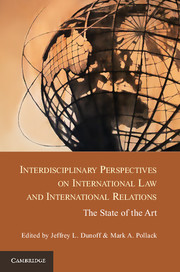 Interdisciplinary Perspectives on International Law and International Relations
Interdisciplinary Perspectives on International Law and International Relations Published online by Cambridge University Press: 05 January 2013
International institutions and organizations influence state behavior and policy. However, the nature of this influence, its extent, and the conditions under which it is most evident are not fully specified and are the subject of much empirical research. One challenge in this empirical exploration has been identifying appropriate outcome variables with which to measure institutional effects. As I argue below, much of the literature, in both political science and international legal studies, has settled on compliance as a dependent variable. The concept of compliance may have certain advantages, such as the relatively systematic and accessible collection of data on patterns of compliance.
However, compliance is a legal concept that is unusually ill-suited to the central social-scientific pursuit: the identification and measurement of causal effects. Identification of the causal effect of an institution requires asking a counterfactual: how would state behavior have varied in the absence of the institution? In most instances, asking about compliance provides no leverage on this question. Compliance is a concept of obvious and inherent interest to lawyers and legal scholars, whose normative focus involves enhancing degrees of compliance. As such, data on compliance are abundantly available. However, political scientists using such data as a proxy for institutional effects make errors of both omission and commission – mistakenly attributing state behavior to institutional participation, and underestimating the influence of institutions on states that are not “in compliance.” This is a dilemma that cannot be addressed by more careful treatment of compliance; it can only be addressed by dropping compliance as a central concept in the study of institutional effects.
To save this book to your Kindle, first ensure [email protected] is added to your Approved Personal Document E-mail List under your Personal Document Settings on the Manage Your Content and Devices page of your Amazon account. Then enter the ‘name’ part of your Kindle email address below. Find out more about saving to your Kindle.
Note you can select to save to either the @free.kindle.com or @kindle.com variations. ‘@free.kindle.com’ emails are free but can only be saved to your device when it is connected to wi-fi. ‘@kindle.com’ emails can be delivered even when you are not connected to wi-fi, but note that service fees apply.
Find out more about the Kindle Personal Document Service.
To save content items to your account, please confirm that you agree to abide by our usage policies. If this is the first time you use this feature, you will be asked to authorise Cambridge Core to connect with your account. Find out more about saving content to Dropbox.
To save content items to your account, please confirm that you agree to abide by our usage policies. If this is the first time you use this feature, you will be asked to authorise Cambridge Core to connect with your account. Find out more about saving content to Google Drive.